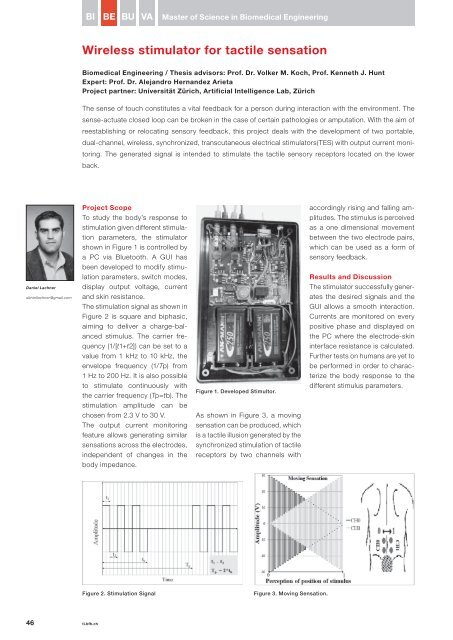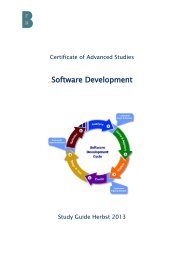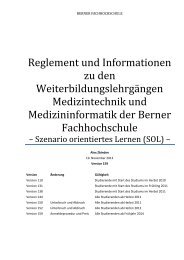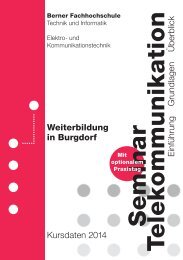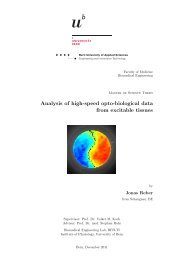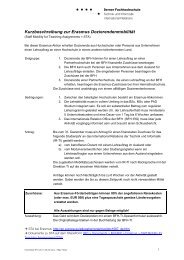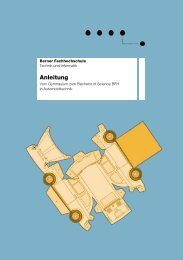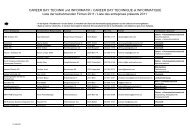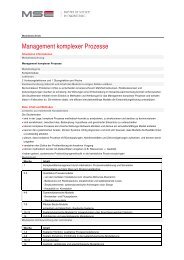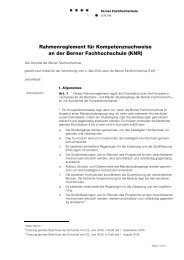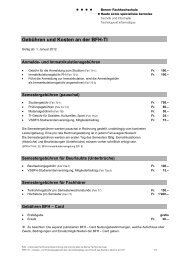- Seite 1 und 2: Berner FachhochschuleHaute école s
- Seite 3 und 4: EditorialWissen und EngagementSavoi
- Seite 5 und 6: Inhalt Contenu ContentsInserenten A
- Seite 7 und 8: Ihre AnsprechpartnerVos interlocute
- Seite 9 und 10: Lehre und Forschung am Puls der Pra
- Seite 11 und 12: Das Masterstudium alsSprungbrett f
- Seite 13 und 14: Steht beim Masterstudium im Vorderg
- Seite 15 und 16: Master of Science in EngineeringEfe
- Seite 17 und 18: BSc in MaschinentechnikBSc en Méca
- Seite 19 und 20: optimalen, zukünftigen Organisatio
- Seite 21 und 22: Master of Science in Engineering
- Seite 23 und 24: Master of Science in EngineeringBIB
- Seite 25 und 26: Master of Science in EngineeringBIB
- Seite 27 und 28: Master of Science in EngineeringBIB
- Seite 29 und 30: Master of Science in EngineeringBIB
- Seite 31 und 32: Master of Science in EngineeringBIB
- Seite 33 und 34: Master of Science in EngineeringBIB
- Seite 35 und 36: Master of Science in EngineeringBIB
- Seite 37 und 38: Master of Science in EngineeringBIB
- Seite 41 und 42: Master of Science in Biomedical Eng
- Seite 43 und 44: Master of Science in Biomedical Eng
- Seite 45 und 46: Master of Science in Biomedical Eng
- Seite 50 und 51: BIBEBUVAMaster of Science in Biomed
- Seite 53 und 54: Managementzentrum Bern
- Seite 55 und 56: ManagementzentrumBIBEBUVASolar Farm
- Seite 57: Adrian ZauggAlumni EMBA Innovation
- Seite 60 und 61: BIBEBUVASoftware-Schule SchweizVirt
- Seite 62 und 63: BIBEBUVASoftware-Schule SchweizRene
- Seite 65 und 66: Medical Technology Center
- Seite 67 und 68: BIBEBUVAMedical Technology CenterEn
- Seite 71 und 72: BSc in AutomobiltechnikBSc en Techn
- Seite 73 und 74: BSc en Technique automobileBIBEBUVA
- Seite 75 und 76: BSc in AutomobiltechnikBIBEBUVAChar
- Seite 77 und 78: BSc in AutomobiltechnikBIBEBUVAREX
- Seite 79 und 80: BSc en Technique automobileBIBEBUVA
- Seite 81 und 82: BSc en Technique automobileBIBEBUVA
- Seite 83 und 84: BSc in AutomobiltechnikBIBEBUVAPrü
- Seite 85 und 86: BSc in AutomobiltechnikBIBEBUVAAuto
- Seite 87 und 88: BSc in AutomobiltechnikBIBEBUVAOld-
- Seite 89 und 90: BSc in AutomobiltechnikBIBEBUVADies
- Seite 91 und 92: BSc in AutomobiltechnikBIBEBUVAReal
- Seite 93 und 94: BSc in AutomobiltechnikBIBEBUVALKW
- Seite 97 und 98:
BSc in Elektro- und Kommunikationst
- Seite 99 und 100:
BSc in Elektro- und Kommunikationst
- Seite 101 und 102:
BSc in Elektro- und Kommunikationst
- Seite 103 und 104:
BSc in Elektro- und Kommunikationst
- Seite 106 und 107:
BIBEBUVABSc in Elektro- und Kommuni
- Seite 108 und 109:
BIBEBUVABSc in Elektro- und Kommuni
- Seite 110 und 111:
BIBEBUVABSc en Électricité et sys
- Seite 112 und 113:
BIBEBUVABSc in Elektro- und Kommuni
- Seite 114 und 115:
BIBEBUVABSc en Électricité et sys
- Seite 116 und 117:
BIBEBUVABSc in Elektro- und Kommuni
- Seite 118 und 119:
BIBEBUVABSc in Elektro- und Kommuni
- Seite 120 und 121:
BIBEBUVABSc in Elektro- und Kommuni
- Seite 122 und 123:
BIBEBUVABSc in Elektro- und Kommuni
- Seite 124 und 125:
BIBEBUVABSc in Elektro- und Kommuni
- Seite 126 und 127:
BIBEBUVABSc in Elektro- und Kommuni
- Seite 128 und 129:
BIBEBUVABSc in Elektro- und Kommuni
- Seite 130 und 131:
BIBEBUVABSc in Elektro- und Kommuni
- Seite 132 und 133:
BIBEBUVABSc in Elektro- und Kommuni
- Seite 134 und 135:
BIBEBUVABSc in Elektro- und Kommuni
- Seite 136 und 137:
BIBEBUVABSc in Elektro- und Kommuni
- Seite 138 und 139:
BIBEBUVABSc in Elektro- und Kommuni
- Seite 140 und 141:
BIBEBUVABSc in Elektro- und Kommuni
- Seite 143 und 144:
BSc in InformatikBSc en Informatiqu
- Seite 145 und 146:
BSc in InformatikBIBEBUVASuisseID
- Seite 147 und 148:
BSc in InformatikBIBEBUVAElektronis
- Seite 149 und 150:
BSc in InformatikBIBEBUVAKryptonIT
- Seite 151 und 152:
BSc in InformatikBIBEBUVATouch - Zu
- Seite 153 und 154:
BSc in InformatikBIBEBUVASpielimple
- Seite 155:
BSc in InformatikBIBEBUVAVSD - Soci
- Seite 158 und 159:
BIBEBUVABSc in InformatikIdentity M
- Seite 160 und 161:
BIBEBUVABSc in InformatikRagnarok G
- Seite 162 und 163:
BIBEBUVABSc in InformatikPolizon -
- Seite 164 und 165:
BIBEBUVABSc in InformatikKinect Int
- Seite 166 und 167:
BIBEBUVABSc in InformatikHeterogene
- Seite 168 und 169:
BIBEBUVABSc in Computer ScienceFace
- Seite 170 und 171:
BIBEBUVABSc in InformatikWebapplika
- Seite 172 und 173:
BIBEBUVABSc in InformatikMashups (D
- Seite 174 und 175:
BIBEBUVABSc en InformatiqueProjet i
- Seite 176 und 177:
BIBEBUVABSc in InformatikRoutenplan
- Seite 178:
BIBEBUVABSc en InformatiqueSwissiVi
- Seite 181 und 182:
BSc in Computer ScienceBIBEBUVAA We
- Seite 183 und 184:
BSc in InformatikBIBEBUVAlibKeynect
- Seite 185 und 186:
BSc en InformatiqueBIBEBUVAMobile W
- Seite 187 und 188:
BSc en InformatiqueBIBEBUVAImplemen
- Seite 189 und 190:
BSc in MaschinentechnikBIBEBUVAVorr
- Seite 191 und 192:
BSc in MaschinentechnikBIBEBUVALuft
- Seite 193 und 194:
BSc in MaschinentechnikBIBEBUVAModu
- Seite 195 und 196:
BSc in MaschinentechnikBIBEBUVAElim
- Seite 197 und 198:
BSc in MaschinentechnikBIBEBUVAAusl
- Seite 199 und 200:
BSc in MaschinentechnikBIBEBUVANeue
- Seite 201 und 202:
BSc in MaschinentechnikBIBEBUVAGree
- Seite 203 und 204:
BSc in MaschinentechnikBIBEBUVASens
- Seite 205 und 206:
BSc in MaschinentechnikBIBEBUVASimu
- Seite 207 und 208:
BSc in MaschinentechnikBIBEBUVAVirt
- Seite 209 und 210:
BSc in MaschinentechnikBIBEBUVARein
- Seite 211 und 212:
BSc in MaschinentechnikBIBEBUVAModu
- Seite 213 und 214:
BSc in MaschinentechnikBIBEBUVASimu
- Seite 215 und 216:
BSc in MaschinentechnikBIBEBUVALeit
- Seite 217 und 218:
BSc in MaschinentechnikBIBEBUVAMach
- Seite 219 und 220:
BSc in MaschinentechnikBIBEBUVAProd
- Seite 221 und 222:
BSc in MaschinentechnikBIBEBUVAModu
- Seite 223 und 224:
MaschinentechnikBIBEBUVAStrahlchara
- Seite 225 und 226:
MaschinentechnikBIBEBUVAKonzepterst
- Seite 227 und 228:
MaschinentechnikBIBEBUVALeckage- un
- Seite 229 und 230:
BSc in MaschinentechnikBIBEBUVAAntr
- Seite 231 und 232:
BSc in MaschinentechnikBIBEBUVAEntw
- Seite 233 und 234:
BSc in MaschinentechnikBIBEBUVAEntg
- Seite 235 und 236:
BSc in MaschinentechnikBIBEBUVAAusk
- Seite 237 und 238:
BSc in MaschinentechnikBIBEBUVARege
- Seite 239 und 240:
BSc in MaschinentechnikBIBEBUVAComp
- Seite 241 und 242:
BSc in Mikro- und MedizintechnikBIB
- Seite 243 und 244:
BSc in Mikro- und MedizintechnikBIB
- Seite 245 und 246:
BSc in Mikro- und MedizintechnikBIB
- Seite 247 und 248:
BSc in Mikro- und MedizintechnikBIB
- Seite 249 und 250:
BSc en Microtechnique et technique
- Seite 251 und 252:
BSc in Mikro- und MedizintechnikBIB
- Seite 253 und 254:
BSc in Mikro- und MedizintechnikBIB
- Seite 255 und 256:
BSc in Mikro- und MedizintechnikBIB
- Seite 257 und 258:
BSc in Mikro- und MedizintechnikBIB
- Seite 259 und 260:
BSc en Microtechnique et technique
- Seite 261 und 262:
BSc in Mikro- und MedizintechnikBIB
- Seite 263 und 264:
BSc in Mikro- und MedizintechnikBIB
- Seite 265 und 266:
BSc in Mikro- und MedizintechnikBIB
- Seite 267 und 268:
BSc in Mikro- und MedizintechnikBIB
- Seite 269 und 270:
BSc in Mikro- und MedizintechnikBIB
- Seite 271 und 272:
BSc en Microtechnique et technique
- Seite 273 und 274:
BSc in Mikro- und MedizintechnikBIB
- Seite 275 und 276:
BSc in Mikro- und MedizintechnikBIB
- Seite 277 und 278:
BSc in Mikro- und MedizintechnikBIB
- Seite 279 und 280:
drive inInnovators in Wire Processi


